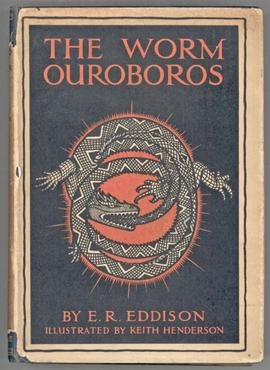Review of The Worm Ouroboros by E.R. Eddison
A.E. Jackson Review Score: 4 / 5 Ravens
How was this review scored?
Which authors come to mind when you consider fantasy? Certain names spring to mind without much effort - George R. R. Martin, J.K. Rowling, Robert Jordan, Terry Pratchett, and Brandon Sanderson. Then there are the giants who cleared the forests and laid down a King’s High Road for all of us to follow - J.R.R. Tolkien, C.S. Lewis, Raymond E. Feist, Ursula K. Le Guin, and Roger Zelazny.
As I study popular novelists, I dig through decades of literature and discover who inspired them to write. Just as you are moved by the words of your favorite author, their heart was filled with a burning fire for story by someone else.
Who wrote the story grand enough to capture the imagination of J.R.R. Tolkien? It so happens that there was such an author - Eric Rücker Eddison. Eddison was an English civil servant and author, born November 24, 1882. He wrote epic fantasy novels under the name E.R. Eddison. The most notable of his works, The Worm Ouroboros (1922), was acknowledged by Tolkien for its influence on his writing.
The Worm Ouroboros formed the landscape of contemporary science fiction and fantasy. Critics of The Lord of the Rings could turn to few other novels for comparison - but referenced this 1922 landmark epic.
The tales is influenced itself by traditions of Homeric epics, Norse sagas, and Arthurian myths. E. R. Eddison blends his compelling adventure, with the majestic narrative style of Shakespeare. Readers are swept away as Eddison recounts bloody battles between warriors and witches, fog-shrouded mountain peaks, and the deepest oceans. There are full story arcs of romance, intrigue, and treachery. If you ever wanted to be swallowed whole by a timeless world, then join generations of fans who have gotten lost in the pages of The Worm Ouroboros.
Through my study of Freud’s Uncanny essay, I've taken a closer look at The Worm Ouroboros. This grand saga illustrates well the cyclical narrative found in literature. The technique returns the main hero back to the starting point with nothing or very little changed. The ending of the story is the very setup of a whole new cycle. Once again, from the beginning.
This was done well in The Worm Ouroboros, The Matrix, and Dark Tower Series to name a few. Going deeper into Joseph Campbell's Hero With A Thousand Faces one finds that the technique has to do with Eastern philosophy and ancient man's storytelling methods. In fact, the whole of creation is set up around birth-death-rebirth - with endless struggle between phases.
When I picked up the tome to begin my journey, it was done with the help of LibriVox narrator Jason Mills. The text of the manuscript can be quite difficult to approach. The style is old by comparison to contemporary fantasy fiction. Even by 1920’s standards, Eddison took great pains to make the phrasing sound even older and more majestic. This hurdle shouldn’t dissuade readers from attempting the feat of finishing the novel. There is a great treasure awaiting the patient reader who sees this one through to the end!
Eric Rücker Eddison (1882 - 1945) was born in England, and worked as a civil servant and author. He wrote epic fantasy novels under the penname E.R. Eddison. Along with The Worm Ouroboros (1922), another of his famous works is the Zimiamvian Trilogy (1935-1958). All of E.R. Eddison's books were written with a meticulous use of the Jacobean prose style. In fact, throughout his pieces one can find fragments of his favorite authors - Homer, Sappho, Shakespeare, and Webster. He was also influenced by Norse sagas and French medieval lyric poems.
Read more from E.R. Eddison at https://www.ereddison.com
You won’t find him on social media - but there are lots of fans out there eager to discuss his work.



